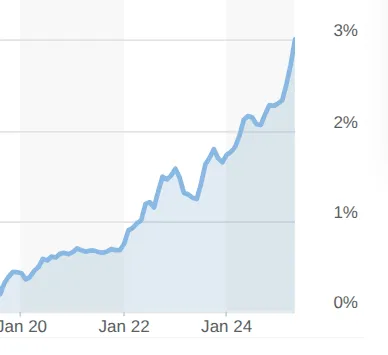Part of understanding the value proposition of cryptocurrency involves realizing the flaws in traditional financial (TradFi), and its unsustainable foundation.
TradFi's model only works if the real economy keeps pace with debt issuance. Otherwise, the system eventually topples under its own weight.
Unlike debt-based fiat currencies like dollars, euros and yen, cryptocurrencies are digital assets that aren't reliant on debt issuance. Rather, they implement novel tokenomics to drive economic activity.
The debt that backs fiat currencies has been on an unsustainable trajectory for decades, and is only getting worse by the day, made evident by Japan's bidless bond auction that took place yesterday.
The 2020 Reverse
Since 2008, central banks had been supporting the stock, real estate, and bond markets worldwide via quantitative easing and artificially low interest rates.
Before 2020, the Bank of Japan (BoJ) bought enough bonds to push rates into negative territory. In fact, the BoJ owns greater than 50% of Japan's bonds. Given Japan's Debt-to-GDP ratio of 250%, super low interest rates are a necessity.
Since the plandemic however, record money printing has caused inflation to soar everywhere, including Japan. The BoJ responded by raising rates, and bond investors started to demand higher rates to compensate for greater risk, and higher inflation.
Japan's Exploding Debt
It would appear that investors are finally starting to lose faith in Japan's ability to service its exploding debt.
The bid-to-cover ratio at Japan's latest bond auction was at its lowest level since 2012. This low demand for Japanese bonds sent interest rates surging to multi-decade highs.

While this may be bullish for gold and Bitcoin (both of which have been hitting fresh all-times highs) it's terrible news for traditional financial institutions.
The Japanese banks, pension funds, and insurance companies that gobbled up bonds at 0% are now entering into insolvency before our eyes.
Marked-to-market, their balance sheets are deep in the red. Why? Because investors would much rather own newly issued bonds that pay 3.1%, pushing down the value of existing bonds that pay near 0%.
BoJ Intervention?
The Bank of Japan could intervene and start buying up these bonds to lower rates, but doing so would kill the yen, and exacerbate rising inflation in Japan.
Allowing interest rates to rise, on the other hand, will make financing government deficits increasingly difficult.
Similar to the Fed and the ECB, Japan's central bank is stuck between a rock and a hard place, and we appear to be nearing the end-game.
Japan is of particular concern when it comes to global contagion due to the famous yen carry trade.
Yen Carry Trade
Thanks to ultra-low (or negative) interest rates since 2016, borrowing yen has been very cheap.
For this reason, traders have been borrowing yen for years, using it to invest in foreign assets (like US growth stocks & bonds) to get higher rates of return.
Now that interest rates are rising in Japan, the carry trade is less attractive, and investors need to cover their yen loans before interest payments get too high.
This could trigger an unwind, and a sell-off of US assets.
Until next time...
It's becoming ever more clear that TradFi's debt-based economics are no longer effective at stimulating growth. Blockchain projects are now experimenting with programmable tokenomics, a new model that will likely power an emerging decentralized economy.
Japan's rising long-term interest rates and their potential ramifications on global markets is yet another sign that a monetary reset is inevitable and coming soon. Here in crypto we have been preparing for this inevitable outcome for years, if not decades.
If you learned something new from this article, be sure to check out my other posts on crypto and finance here on the Hive blockchain. You can also follow me on InLeo for more frequent updates.
Further Reading
- Three Emerging DePIN Projects On The Polygon Blockchain
- Three Up-And-Coming DePIN Projects On The Solana Blockchain
- Three Promising DePIN Projects In The Cardano Ecosystem
Sources
Japanese 30-year bond chart [1]